The Galileo Energetic Particles Detector
Galileo EPD Handbook
Chapter 1. Instrument Summary
LEMMS Calibrations
Source: EPD Team Meeting, February 1984 (excerpts)
The following figures show the results of detailed calibrations performed at the GSFC calibration facility. Shown are the outline of the LEMMS 0° collimator, a circle representing the beam diameter, and electron detection efficiencies obtained for numerous sweeps across the collimator opening. Several energies are shown which represent the level and gradient portions of the maximum peak electron efficiency curve. These runs should allow an excellent characterization of the electron response for the LEMMS detector. These runs totaling 1200 individual measurements were obtained by E. Bubla, H. Sommer, B. Wilken and J. Kohl.
Figure 1-85 shows a three-dimensional perspective of the measured efficiencies as developed by W. Studemann.
In addition to the accelerator calibrations, extensive work has been done to characterize the EPD performance using laboratory pulsers. Preliminary analysis of the data indicates performance limitations on the LEMMS A, E, and F channels are not significant until 300-600 KHz rates are seen.
 |
Figure 1-79. Maximum electron detection efficiency observed at any entering angle to the opening aperture. |
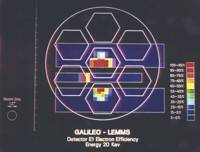 |
Figure 1-80 |
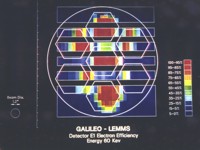 |
Figure 1-81 |
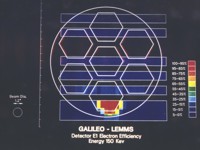 |
Figure 1-82 |
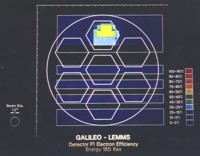 |
Figure 1-83 |
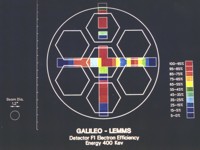 |
Figure 1-84 |
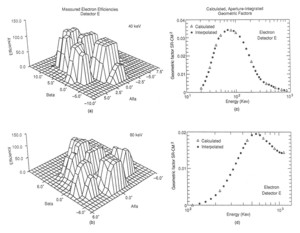 |
Figure 1-85. Three-dimensional perspective. |
Return to Galileo EPD Handbook Table of Contents Page.
Return to main
Galileo Table of Contents Page.
Return to Fundamental
Technologies Home Page.
Updated 8/23/19, Cameron Crane
QUICK FACTS
Mission Duration: Galileo was planned to have a mission duration of around 8 years, but was kept in operation for 13 years, 11 months, and 3 days, until it was destroyed in a controlled impact with Jupiter on September 21, 2003.
Destination: Galileo's destination was Jupiter and its moons, which it orbitted for 7 years, 9 months, and 13 days.



